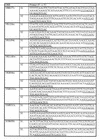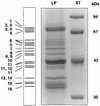Identification and characterization of major lipid particle proteins of the yeast Saccharomyces cerevisiae
- PMID: 10515935
- PMCID: PMC103780
- DOI: 10.1128/JB.181.20.6441-6448.1999
Identification and characterization of major lipid particle proteins of the yeast Saccharomyces cerevisiae
Abstract
Lipid particles of the yeast Saccharomyces cerevisiae were isolated at high purity, and their proteins were separated by sodium dodecyl sulfate-polyacrylamide gel electrophoresis. Major lipid particle proteins were identified by mass spectrometric analysis, and the corresponding open reading frames (ORFs) were deduced. In silicio analysis revealed that all lipid particle proteins contain several hydrophobic domains but none or only few (hypothetical) transmembrane spanning regions. All lipid particle proteins identified by function so far, such as Erg1p, Erg6p, and Erg7p (ergosterol biosynthesis) and Faa1p, Faa4p, and Fat1p (fatty acid metabolism), are involved in lipid metabolism. Based on sequence homology, another group of three lipid particle proteins may be involved in lipid degradation. To examine whether lipid particle proteins of unknown function are also involved in lipid synthesis, mutants with deletions of the respective ORFs were constructed and subjected to systematic lipid analysis. Deletion of YDL193w resulted in a lethal phenotype which could not be suppressed by supplementation with ergosterol or fatty acids. Other deletion mutants were viable under standard conditions. Strains with YBR177c, YMR313c, and YKL140w deleted exhibited phospholipid and/or neutral lipid patterns that were different from the wild-type strain and thus may be further candidate ORFs involved in yeast lipid metabolism.
Figures



References
-
- Abraham P R, Mulder A, Van’t Riet J, Planta R J, Raue H A. Molecular cloning and physical analysis of an 8.2 kb segment of chromosome XI of Saccharomyces cerevisiae reveals five tightly linked genes. Yeast. 1992;8:227–238. - PubMed
-
- Athenstaedt, K. Unpublished observation.
-
- Athenstaedt, K., and D. Sorger. Unpublished data.
Publication types
MeSH terms
Substances
LinkOut - more resources
Full Text Sources
Other Literature Sources
Molecular Biology Databases

